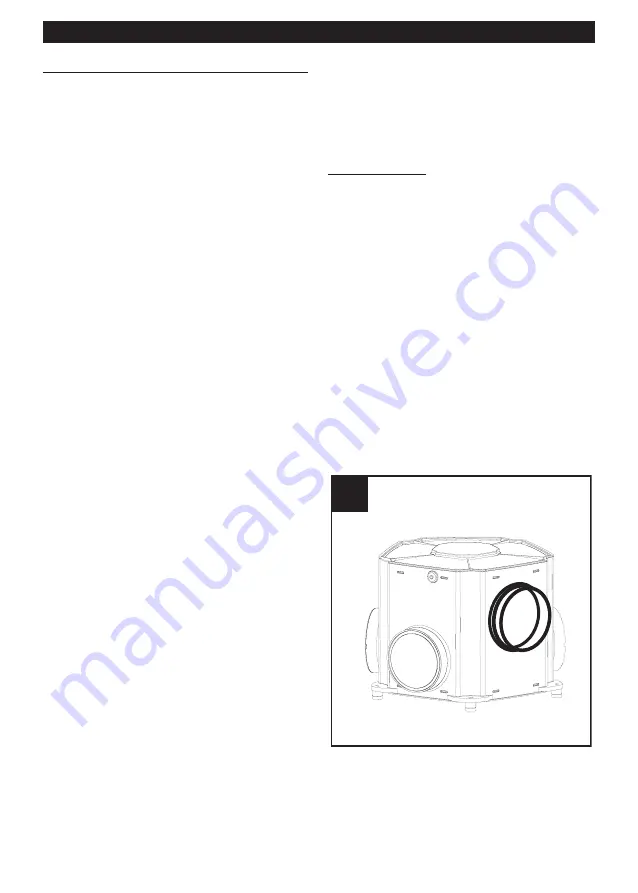
Compliance with Building Codes
The 2006 Edition of the U.K Building Regulations
Approved Document F1: Means of Ventilation
(applicable in England and Wales) details 4 clearly
defined systems of ventilation to dwellings. System 3 -
Continuous mechanical extract (MEV) is complied with
by the INVAVENT MAXI ultra-high efficiency whole house
extract ventilation system.
System 3- Continuous mechanical extract requires a
"minimum high rate" in each wet room to be achieved
(Kitchens 13 l/s and both utilities and bathrooms 8 l/s -
sanitary only 6 l/s).
The "minimum low rate" is calculated by taking the
number of bedrooms in the dwelling and applying the l/s
value from Table 1.1b (pag.7). In addition the rate should
be no less than 0.3 l/s per m_ of internal floor area (all
storey’s) plus for each additional occupant over and
above the anticipated two for the first bedroom and one
for each of the others a further 4 l/s must be added to the
extract rate. The system provides quiet, uninterrupted
extract ventilation from the dwelling via all the wet
rooms, creating a permanent air path through the
property from the “dry” habitable rooms to the “wet”
rooms.
The current Building (Scotland) Regulations refers to
continuously operating mechanical extract ventilation in
accordance with the guidance in BRE (Building
Research Establishment) Digest 398, a paper based on
the former government department’s (and now private
company) own tests and recommendations , specifically
0.5 air changes per hour throughout the property.
The INVAVENT MAXI complies fully with the
recommendations contained within this document.
In Ireland, Technical Guidance Document (TGD) 2008
Part F: Ventilation is applicable and the INVAVENT MAXI
complies fully with the recommendations contained
within this document.
With the Governments actively encouraging energy
saving and a target for all new homes to be ‘carbon zero’
by 2016, the INVAVENT MAXI has been designed ‘future
proof’.
The ‘Code for Sustainable Homes’ which came into
force in March 2007, details six levels of CO2 emission
improvement
over
2006
Building
Regulations
requirements.
To achieve the three highest levels of reduction of carbon
emissions, the air leakage of the dwelling must be
improved so significantly that continuous ventilation
becomes the only appropriate method. In addition, it
must be demonstrated that the ventilation system itself
must be energy efficient. The INVAVENT MAXI has been
independently tested by the Building Research
Establishment (BRE) to the appropriate SAP (1)
Appendix Q test methodology and is therefore Appendix
Q eligible.
(1) The Governments Standard Assessment Procedure
(SAP) is a method assessing the energy performance of
dwellings and SAP Appendix Q provides an allowance
for the benefits of energy-saving appliances; products
may be independently assessed and the results
uploaded to the SAP website.
Description
Comfort and energy efficiency are becoming
increasingly important factors in buildings. With this in
mind, appliances are being developed to control the
micro-climate within homes and to provide a high
degree of comfort along with energy efficiency. These
appliances silently and continuously ventilate homes
removing humidity from service areas (bathrooms,
kitchens, etc.) and creating a flow of “dry” air in “lived-
in” areas (dining areas, studies, bedrooms, etc.). The
INVAVENT MAXI centralised ventilation systems has
been specifically designed for continuous ventilation
in domestic applications and may also be used in
some commercial applications.
The INVAVENT MAXI is fitted with brushless three-
phase motors with electronically controlled three-
speed operation.
The INVAVENT MAXI is a modular appliance that
means maintaining and replacing parts is both quick
and easy.
The appliance can be wall or ceiling mounted. The unit
has 5 vents: the one positioned at the top right (fig 1)
is for expelling stale air; the other 4 (fig. 2) extract
humidity and stale air.
1
1
3
ENGLISH
Summary of Contents for InvaVent MAXI
Page 1: ...Instruction booklet COD 5471 084 960 09 03 2018 MAXI ...
Page 10: ...10 ENGLISH ...
Page 11: ...11 ENGLISH ...
Page 13: ...13 ENGLISH ...


































